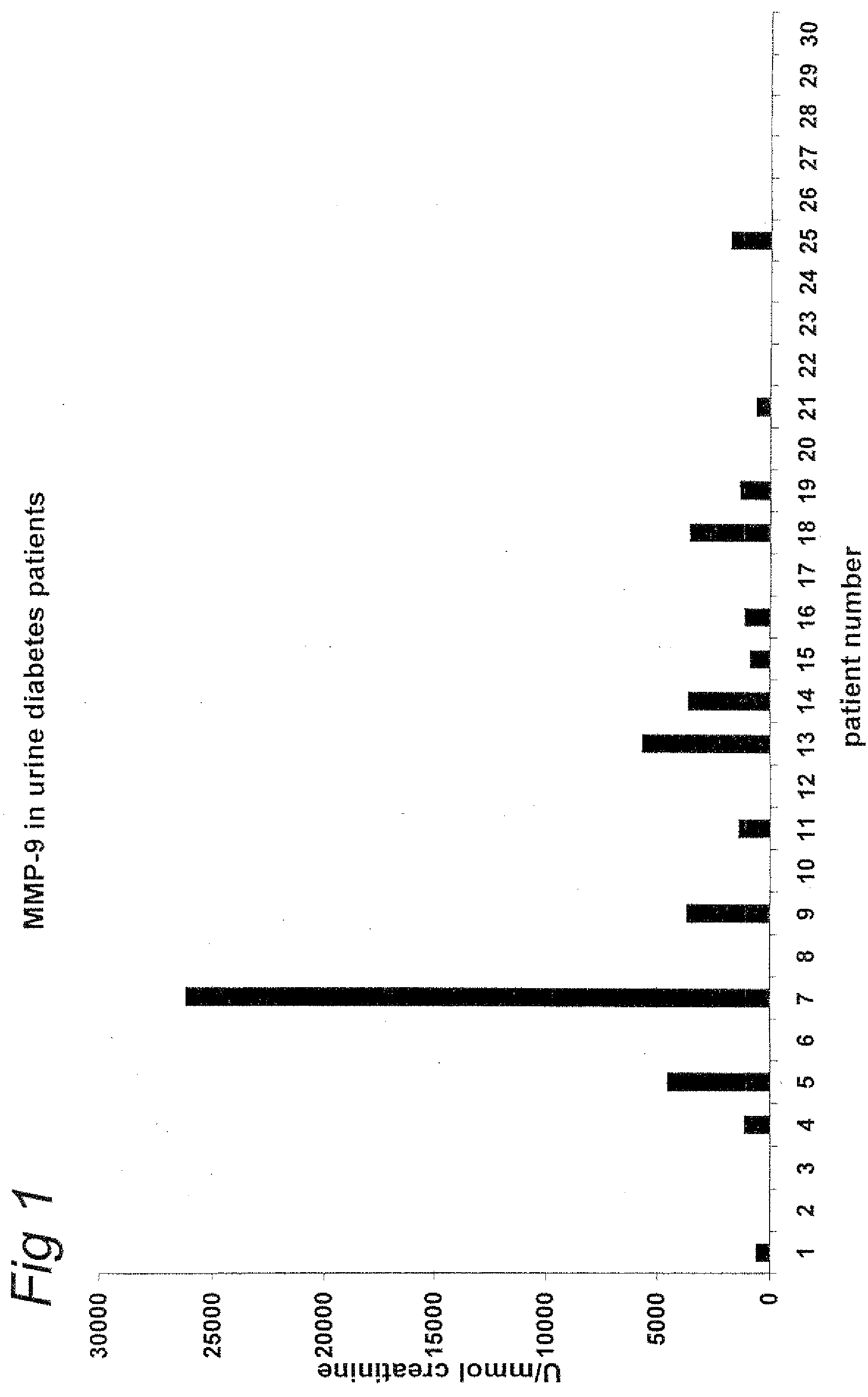Proteolytic enzymes in urine as diagnostic parameters in diseases involving matrix remodelling
a technology of proteolytic enzymes and urine, which is applied in the direction of instruments, enzymology, biochemistry apparatus and processes, etc., can solve the problems of cumbersome measurement of proteolytic enzymes in peripheral blood, serum or plasma, and no reference discloses or suggests to determine proteolytic enzymes in urine samples, etc., to achieve convenient yet very reliable and powerful
- Summary
- Abstract
- Description
- Claims
- Application Information
AI Technical Summary
Benefits of technology
Problems solved by technology
Method used
Image
Examples
example i
Measurement of MMP-2 Antigen in Serum of Healthy Controls and Diabetic Patients with and without Albuminuria
[0086]The level of matrix-metalloprotease-2 (MMP-2) antigen in serum of healthy control (n=9) and patients with type I diabetes with (n=16) and without (n=140) albuminuria was determined using a commercially available ELISA (Amersham Pharmacia Biotech RPN 2617 kit).
[0087]No significant differences in levels between the various groups were found: control 547±38 ng / ml, diabetes patients with albuminuria 608±42 ng / ml and diabetes patients without albuminuria 612±44 ng / ml (mean±SEM).
example ii
Measurement of MMP-9 Antigen in Serum of Healthy Controls and Diabetic Patients with and without Albuminuria
[0088]The level of matrix-metalloproteases-9 (MMP-9) in serum of healthy controls (n=9) and patients with type I diabetes with (n=16) and without (n=14) albuminuria was determined using a commercially available ELISA (Amersham Pharmacia Biotech RPN 2614 kit). Patient serum MMP-9 levels were significantly increased versus controls (508±38 ng / ml vs. 159±17 ng / ml; p<0.001). No difference was observed between patients with and without albuminuria.
example iii
Inactive pro-forms of MMPs are converted to active forms by treatment with amino-phenyl-mercuric-acetate (APMA)
[0089]A MMP containing sample after immunocapture is incubated with 0.5 mM APMA at 37 C for 2 h (MMP-9) or 0.5 h (MMP-2) as described in the instructions of the manufacturer of the kits. Measurement without APMA treatment gives active MMP present in the sample, whereas measurement after APMA treatment gives active and activatable pro-enzyme in the sample.
PUM
| Property | Measurement | Unit |
|---|---|---|
| time | aaaaa | aaaaa |
| physical separation | aaaaa | aaaaa |
| HPLC | aaaaa | aaaaa |
Abstract
Description
Claims
Application Information
 Login to View More
Login to View More - R&D
- Intellectual Property
- Life Sciences
- Materials
- Tech Scout
- Unparalleled Data Quality
- Higher Quality Content
- 60% Fewer Hallucinations
Browse by: Latest US Patents, China's latest patents, Technical Efficacy Thesaurus, Application Domain, Technology Topic, Popular Technical Reports.
© 2025 PatSnap. All rights reserved.Legal|Privacy policy|Modern Slavery Act Transparency Statement|Sitemap|About US| Contact US: help@patsnap.com



